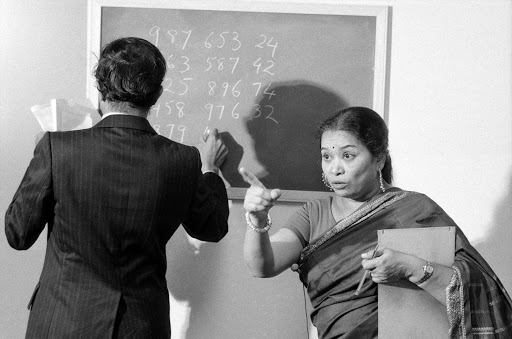Shakuntala Devi
Who was Shakuntala Devi?
Her excellent skill has brought her a renowned name as “Human-Computer.” Shakuntala Devi was also an author and showcased her wisdom through books on astrology, puzzles, and mathematics.
She made our country proud by securing a place in “The Guinness Book of World Records” for her intellectual mathematical talent. Also a motivational speaker who enlightened the lives of many individuals towards mathematics.
In 1960, she married Paritosh Banerjee and was blessed with a daughter. Internationally acclaimed mathematician Shakuntala Devi was genuinely a wonder on earth whose life journey needs to be known by students and parents.
Why is Shakuntala Devi famous?
Most of the time, people were astonished by Devi’s mathematical excellence. People were always thinking about how Shakuntala Devi calculates such huge numbers randomly assigned to her in an instant. She was an extraordinary human with impeccable calculating skills that brought her the title “Human-Computer.”
On 18th June, 1980 at Imperial College London she demonstrated multiplication of two complex 13-digit numbers such as 7,686,369,774,870 x 2,465,099,745,779.
Those numbers were given randomly, and Devi answered it as 18,947,668,177,995,426,462,773,730 in just 28 seconds, it has brought her worldly fame. She never used any paper or pen to calculate the numbers; it was her mental ability to determine the right answer in her mind.
All of these outstanding accomplishments were achieved without taking any higher degree of education. Her talent for arithmetic calculation made her famous, and she deserved the magnificent titles given for her talents.
Devi had an immense passion for numbers, and that extended her interest in astrology too. Her strength of numbers was applied to the pursuit of astrological knowledge. She even impressed many with her astrology predictions about them. Devi has also expressed her passion for writing through books, which made her author of diverse genres.
Her perseverance in aspiring to be famous emerged when she acknowledged her rare supreme talents and utilized them for good. Her presence was an honor to the country, and she will always be remembered as one of the great mathematician.
Awards and Achievements of Shakuntala Devi
The authenticity of Shakuntala Devi’s talents gained her many awards and achievements. One of the well-known titles that capped her talent is “Human-Computer.” She outperformed the most sophisticated computers at the time and mesmerised people with her mathematical capabilities.
In 1980, Devi’s successful attempt to multiply two random 13-digits in 28 seconds was recorded for the year 1982 of The Guinness Book of World Records.
One of her talents include her writings such as:
- Figuring: The Joy of the Numbers, More puzzles to Puzzle You, In The Wonderland of Numbers, The Book of Numbers, Awaken Genius in Your Child, Super Memory - It Can be Yours, Perfect Murder, Astrology For You, System of Education, Rural Credits and Agriculture Development, Caste System in India, Women’s Status and Social Change.
Devi has written books on mathematical calculations, memory power, social issues, puzzles, and mysteries. A few books written by Devi have the tricks and tips to improve mathematical ability and enhance memory.
She has also written books related to social issues that are inspiring and educational. Devi has added fun into Maths and explained it as the most easy-going concepts to learn. It has inspired many students to take forward their mathematical abilities.
The early life of the mathematical prodigy
Shakuntala Devi’s parents lived in Bangalore and belonged to a Kannada Brahmins community. At the tender age of 3, Devi’s father, Mr. Sudhararaja Rao, discovered her mathematical talent during a card trick. Later, he has also taken Devi for roadshows to demonstrate her mathematical skills in schools and colleges.
At the age of 6, Devi has performed her arithmetic skills at the University of Mysore. She has achieved all these without any formal education. Thus, her tours to different parts of the world began and made her a world-famous Indian mathematician.
People who attended her shows would randomly ask her numbers to calculate or find the day with the date provided. Her answers were always perfect and faster than they would expect. Many people at the top universities wondered, “How Shakuntala Devi Calculates?”.
Devi’s greatest passion for calculating complex numbers has taken her to many unique places around the globe. She demonstrated her arithmetic abilities before many students and motivated young minds to discover mathematics’s beauty and simplicity.
Interesting Facts about the mathematical prodigy
Devi did not like the title of Human-Computer given to her. She stated that the human brain’s ability is far greater than a computer and should never compare both.
In the year 1980, she contested in the election for the parliament seat in two different localities against Indira Gandhi and lost. Devi has been a respected personal astrologer to many politicians, movie stars, and business personnel.
A movie titled “Shakuntala Devi” has been created based on her life. Released in the year 2020, it showcased the life of Shakuntala Devi and captured her indomitable spirit.
When did Shakuntala Devi die?
Shakuntala Devi’s demise has been a massive loss to the field of mathematics in India. The fantastic journey of mathematical prowess, respected astrologer, inspirational author, and an honourable individual ended on 21st April 2013.
She passed away due to cardiac and respiratory failure. Before that, she also had kidney and heart complications. People will always remember her spell bound calculations and inspirational spirit.

















